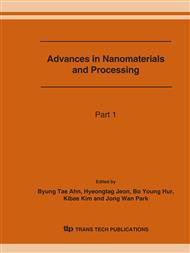p.1693
p.1697
p.1701
p.1705
p.1709
p.1713
p.1717
p.1721
p.1725
Encapsulation of Municipal Solid Waste Incineration Bottom Ash to Immobilize Cu and Pb via Carbonation Reaction
Abstract:
Bottom ash generated from municipal solid waste incinerators in metropolitan areas contain calcium and aluminum compounds. As a result of a carbonation reaction, calcite and a calcium aluminum compound (Na6CaAl6Si6O24, Ca2Al2SiO7) as well as amorphous aluminum oxide can be found in bottom ash. Due to this, Cu and Pb leaching concentrations decrease via a carbonation process. Recently, the study of artificial carbonation reaction has been actively investigated, but most of these studies have been carried out utilizing an aqueous solution method with high water content. In this study, the carbonation reaction takes place in an aqueous environment, but does not occur on the surface of the particle. However, to cause the encapsulation of a particle with calcite, calcium aluminum compound and amorphous aluminum oxide, these must be formed on the surface of particle. Therefore in this study, a low water content encapsulation method of bottom ash from municipal solid waste incinerator was investigated with a view to immobilize Cu and Pb via a carbonation reaction. As seem in the results, the encapsulation effect appeared to be successful, with a water content of 20%.
Info:
Periodical:
Pages:
1709-1712
Citation:
Online since:
June 2007
Authors:
Keywords:
Price:
Сopyright:
© 2007 Trans Tech Publications Ltd. All Rights Reserved
Share:
Citation:


